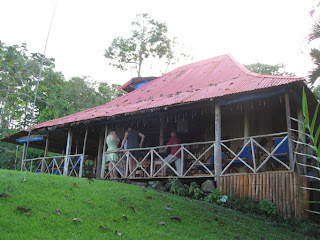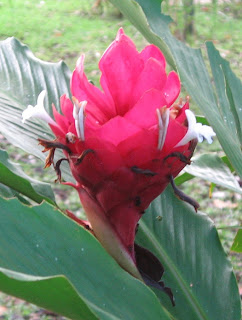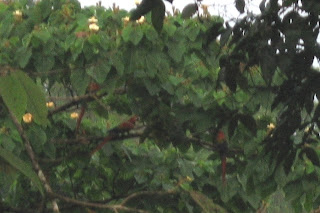Howard and I wanted to have a very restful vacation during winter break, our first in three years, and I don't think we could have found a better place. After buying 4 or 5 new guide books and borrowing others from the library, searching the web and reading reviews on Trip Advisor, we finally settled on staying at Las Caletas, a small all-in-one hotel with 5 cabin rooms and 2 newly-set up tents, just north of the Corcovado National Park and a bit south of Drake Bay in Southwestern Costa Rica, on the Osa Peninsula.

See http://www.caletas.co.cr/ We made our reservations 3 months in advance, but the regular rooms were already taken, so we agreed on one of the tents, and it was great! We made a great decision. The place was wonderful--with solar energy instead of a generator in most of the surrounding places--a very warm group of employees, great, healthy food, and an incredible environment.
After finishing teaching, Howard came home, ate, changed clothes, and we headed to the airport. We took an 11:30 p.m. flight on Continental to Houston, had a layover for 3 hours, and then flew to San Jose, Costa Rica. We breezed through customs with just carry-on luggage and walked 2 blocks to the National airport for Sansa Airlines. It was just one tiny, crowded room. The picture shows half of the public area. Note the baggage cart on the right.
After finishing teaching, Howard came home, ate, changed clothes, and we headed to the airport. We took an 11:30 p.m. flight on Continental to Houston, had a layover for 3 hours, and then flew to San Jose, Costa Rica. We breezed through customs with just carry-on luggage and walked 2 blocks to the National airport for Sansa Airlines. It was just one tiny, crowded room. The picture shows half of the public area. Note the baggage cart on the right.
Our flight was due to leave at 2:20, but nothing was announced until about 2:40. We were screened individually and then walked out to board. There was a giant step up to get on the ladder, and no one over4 feet tall could stand up in the plane!
We flew from there to Drake Bay, with a quick stopover on the southern tip of the Osa Peninsula at Puerto Jimenez. Costa Rica has only two "real" airports. There are many other smaller landing strips for prop planes. They are comprised usually of a small building and one landing strip, often not as wide as the wing span of the prop planes. We flew on a single-engine Cesna Caravan, originally built for 8 but configured for 12 passengers and pilot and co-pilot. We were limited to 25 lb each (including carry-ons), and we had to tell our weight too! We flew rather low and the views were breathtaking.
Below is the runway at Puerto Jimenez
Drake Airport--during the worst rainy season from September through November, planes cannot fly into Drake airport because there is no way to get passengers to other places as the rivers are too swollen to drive through with 4x4s. So planes fly into Palma Sur/Norte and people go by boat through the mangrove-lined river to the Pacific. We arrived as the rains were slowing down a lot. It still rained daily, but except for one day, there was sun every day during our stay.

At the airport, we got into a 4x4 Toyota "cab" and went for about 25 minutes to where we caught a boat for a ten-minute ride to our home for the next week, Las Caletas. The cab went through two shallow rivers and over a very bumpy and sometimes muddy dirt road. It passed through the tiny town of Aguhitas (500 people), which just got electricity 2 or 3 years ago. It has a few small hotels, 3 churches (Catholic, Pentacostal and Baptist--70% of the population is Catholic) and an elementary school with 75 students and a secondary school with 45 students. Elementary school is compulsory, and 98% of the people in Costa Rica are literate, a higher rate than in the US.
We were warned that we would get in the water when we got in and out of this boat, and you can see that we did!

There are a number of different places to stay along the shore, each at least a quarter of a mile apart. Many are at shoreline level, but ours was up a hill, not visible from below. We walked up an inclining path to get to Las Caletas. It was drizzling when we arrived, and 2 employees carried are bags, one being a young 22-year-old named Guillermo. We didn't bring a lot since we were just staying at this lodge and dress was informal....and we were only allowed 25 lb on the plane. Guillermo showed us around, showing us the main common area,

There are a number of different places to stay along the shore, each at least a quarter of a mile apart. Many are at shoreline level, but ours was up a hill, not visible from below. We walked up an inclining path to get to Las Caletas. It was drizzling when we arrived, and 2 employees carried are bags, one being a young 22-year-old named Guillermo. We didn't bring a lot since we were just staying at this lodge and dress was informal....and we were only allowed 25 lb on the plane. Guillermo showed us around, showing us the main common area,
introduced us to our semi-private bathroom (we shared it with a couple from Montreal in the tent behind us), less than 15 feet from our tent porch, and told us about meals and the honor system on drinks. Beer and glasses of Chilean wine were $2 each, and each time we had some, we were to indicate it on a chart. Ditto for using the Internet.
Many of the other lodges used a generator for power, shutting off the power during the middle of the day and after dinner. Because Las Caletas uses solar power, we had electricity all the time.

One of four cabins
The view from the tent at night was spectacular. We even captured a photo of the full moon.
We walked along the shore a lot. There was a good path that went on for kilometers. Sometimes the beach was sandy, but most often the shoreline was rocky with the forest/jungle going right up to the water's edge.
A nearby Beach
 Fresh water stream draining into ocean. Such streams were plentiful.
Fresh water stream draining into ocean. Such streams were plentiful. Dina by trees with above ground roots
Dina by trees with above ground rootsWe also saw interesting animals along the shoreline
 termite hive
termite hive basilisk baby on log
basilisk baby on log bittern (a kind of heron) "hiding"
bittern (a kind of heron) "hiding" High tide crab running toward hole. Howard enjoyed chasing a bunch of them!
High tide crab running toward hole. Howard enjoyed chasing a bunch of them! crab prints in the sand
crab prints in the sand We saw blue morpho butterflies, about 6" in diameter, but they never stopped for us to take a picture. They are spectacular!
We saw blue morpho butterflies, about 6" in diameter, but they never stopped for us to take a picture. They are spectacular!I had fun walking the beaches and collecting shells. The bigger ones, however, were at Cano Island, and we did not go there. We really enjoyed swimming in the ocean. The water was quite warm, and the sheltered beach below our lodge was lovely. We sometimes went in by ourselves. At most, 6 other people were in with us. At low tide, we just had to go beyond where the waves broke (about twenty feet out). We were then a bit below my waist level and on a flatledge and could swim or just jump and the waves came it. It was delightful.
There were not a lot of flowers, but the ones we did see were quite colorful. Most were planted where people lived.
There were not a lot of flowers, but the ones we did see were quite colorful. Most were planted where people lived.


 hybiscus
hybiscus
 orchid
orchidThere were also a lot of birds and other animals visible around the cabins and where we ate including this toucan who made an appearance each morning and late afternoon. Howard saw many birds by sitting on our porch at 6 a.m. and after 4 p.m. They included a variety of tanagers, ant wrens, black hawks, friggatebirds, lots of pelicans, terns, black vultures, green parrots, etc. Howard heard a lot of howler monkeys in the very early morning around 5 p.m. (I slept soundly and only heard them once.) We saw a group of about ten white-faced capuchin monkeys just above the beach one morning, and beforehand they had walked really close to our eating area.
 Toucan near dining room each morning
Toucan near dining room each morning Bug inside lampshade near ceiling in eating area just before a heavy rainstorm
Bug inside lampshade near ceiling in eating area just before a heavy rainstorm Iguana on tree to the right of eating area, seen daily from early morning until early afternoon, sunning himself
Iguana on tree to the right of eating area, seen daily from early morning until early afternoon, sunning himselfThere were a number of tours that are available....to the Corcovado national park, to Cano island to snorkel, etc. One would see more animals, including sloths, anteaters, etc., but I had seen many of them when I lived on the Amazon and Howard preferred not to go.
We really enjoyed our meals in the common area and just sitting, reading and watching our surroundings there. To enter the common area (including where we ate), everyone removed shoes. The floors were washed often and were so clean that one could probably eat off of them. They also kept our tent very clean, and once we learned to take off our shoes on getting on the porch, we also kept it clean!
 Just before lunch
Just before lunchBreakfasts (served from 6:30 to 8:30 a.m.) usually included rice and beans (pinto), eggs, and fresh fruit (papaya, pineapple--the best I have ever tasted, watermelon, and mango daily) plus freshly baked bread. If the eggs had any meat mixed in with them, they made a special batch for us, vegetarian style. While many Costa Ricans cook with lard, this place only uses olive oil. Lunch at 12:30 was vegetarian (sometimes with tuna)--a main dish and salad of some sort. There was fresh Costa Rican coffee and hot milk available all day and a freshly made dessert available from about 11 a.m. until it ran out, late in the afternoon. Dinner was a social event, starting around 6:30 and ending around 8 p.m. with a marvelous dessert at the end. We had lovely chicken dishes, beef stew one night, and freshly caught fish twice. The fish were caught in late morning, and served 7 hours later. We ate yellow fin tuna susha (the freshest I have ever had), grilled tuna and also grilled "dorado," also called "dolfinfish" or mahi mahi. Both, especially the latter, were better than in any restaurant that we have had fresh fish in. The food was always presented in an attractive way, with much care. The portions were not huge, but food was plentiful. Dinner was often buffet, so anyone could go back for seconds. A special meal was planned for Xmas eve, and I took pictures. Although there was a special meal, Xmas was not played up. As in other parts of Latin America, Christmas is a religious holiday and not very commercial as in the US.
 Best sushi we've ever had
Best sushi we've ever had Dinner time with Stella and Alain from Quebec
Dinner time with Stella and Alain from Quebec Palm leaves drying to be used to wrap tamales
Palm leaves drying to be used to wrap tamalesThe last morning after an early breakfast, we said our goodbyes and headed off by boat to the town of Sierpe. To get there we went up the Rio Sierpe. Much of it is lined by mangroves, and at times the river is quite narrow, so we got very close to these plants. The mangrove is one of several tropical evergreen trees or shrubs of the genus Rhizophora, having stiltlike roots and stems and forming dense thickets along tidal shores. Our boat got very close, and I was able to take a few good photos.
From Sierpe, we took a cab on a paved road to Palma Sur where we caught a bus to San Isidro de General, which was half way to San Jose. The ticket to San Jose cost about $8. We chose to stay overnight in San Isidro to break up the five to six-hour trip. The drive along the Pan American Highway (a two-lane road with very tiny shoulders in some parts) was pretty, especially north of San Isidro where we went over a mountain range. The towns surprised me as they had none of the greenery that we saw in the rural areas. We got to the airport way before our flight. The San Jose airport has a few shops and a few eateries, all of which are pretty gross American fast food places. We did find a kosher sandwich, but it was salami.
If we return to Costa Rica, I would love to stop in Sarchi for a day or so. It is within an hour of San Jose and is the main artesan town in the country.
This trip was lovely, different from our visit to the Monte Verde area three years ago, but equally if not more enjoyable.



















































